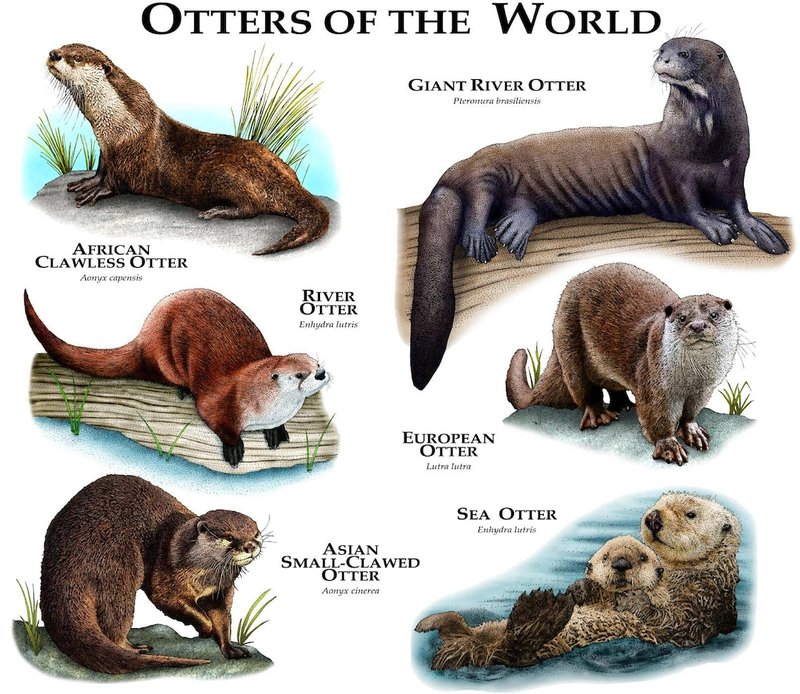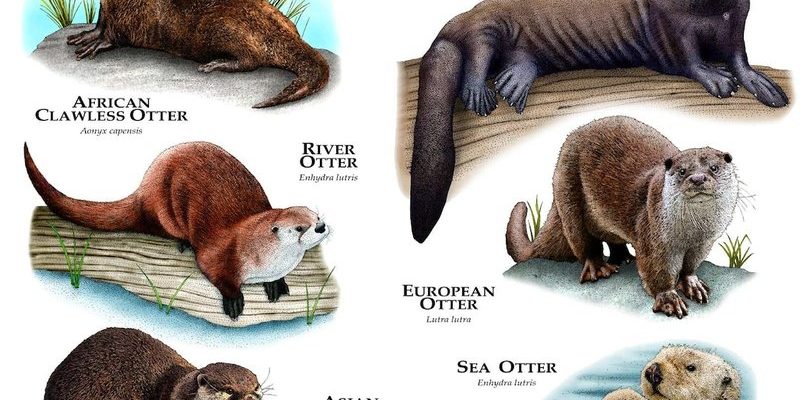
Otters are fascinating creatures that thrive in various environments, from rivers and lakes to oceans. However, their habitats differ based on the species. Imagine otters as the ultimate survivors, adapting to their surroundings like chameleons. They have unique ways of making the most of their environments, which is part of what makes them so captivating. So, grab a cup of coffee, and let’s unravel the mystery of where otters live!
Types of Otters and Their Habitats
Otters belong to a group known as the Mustelidae family, which includes weasels, ferrets, and badgers. There are 13 different species of otters worldwide, each adapted to its unique habitat. You might be familiar with the North American river otter, the playful sea otter, or the charming Asian small-clawed otter. Each species has its preferred environment, ranging from freshwater to saltwater.
– River Otters: These guys love freshwater habitats. You’ll typically find them in rivers, lakes, and marshes. They prefer areas with plenty of vegetation and cover to hide from predators. River otters are excellent swimmers and can dive to catch fish and crustaceans.
– Sea Otters: As the name suggests, these otters thrive in marine environments. They inhabit coastal regions, often found in kelp forests. Sea otters are critical to their ecosystems, helping control sea urchin populations that can devastate kelp forests.
– Asian Small-Clawed Otters: These tiny otters prefer mangroves, swamps, and wetlands. They are the smallest otter species and are known for their playful behavior. Their homes are often close to water, making it easy for them to hunt and socialize.
Freshwater Habitats: Rivers and Lakes
Many otter species are perfectly at home in freshwater habitats. Rivers and lakes provide plenty of food and shelter. The North American river otter, for example, is often spotted in these environments. They thrive in areas where there’s abundant plant life, which helps create a rich ecosystem teeming with fish, frogs, and other aquatic life.
Rivers are particularly beneficial for otters because they offer flowing water, which can help keep their hunting grounds fresh. Otters love to hunt in areas where they can dive deep and navigate through the underwater vegetation. They’re agile swimmers, using their sleek bodies to dart through the water in pursuit of their next meal.
In addition to being well-fed, freshwater habitats also offer safety. Dense vegetation along riverbanks and lake shores gives otters places to hide from predators like coyotes and birds of prey. They may even use riverbanks for lounging in the sun or raising their young!
Marine Habitats: Sea Otters and Coastal Regions
Now, let’s take a look at the marine habitats where sea otters thrive. Unlike their freshwater cousins, sea otters are true ocean dwellers. They are often found along the Pacific Coast of North America, where they can establish their homes in coastal areas with plenty of kelp forests.
Kelp forests are crucial to sea otters because they provide shelter and food. These underwater jungles are teeming with sea urchins, crabs, and various fish species—all tasty treats for sea otters. In fact, sea otters play an essential role in maintaining the health of these ecosystems. By eating sea urchins, they prevent overgrazing of kelp forests, which can lead to a decline in biodiversity.
Sea otters are also known for their unique habits. They often wrap themselves in kelp to keep from drifting away while they sleep! Imagine taking a nap in a cozy seaweed hammock—sounds relaxing, right? This adaptation allows them to rest while staying close to their hunting grounds.
Wetlands and Marshes: A Hidden Oasis
Wetlands and marshes are like hidden gems for otters. These areas are rich in biodiversity and provide essential habitats for many species, including otters. The Asian small-clawed otter is often found in these environments, where it takes advantage of the abundant food supply.
Wetlands are crucial for water management and flood control. They help maintain the water cycle and provide a habitat for various plant and animal species. Otters thrive in these ecosystems, hunting for fish, amphibians, and invertebrates. The shallow waters allow them to dive and forage easily, making it a perfect spot for raising a family.
Moreover, wetlands also offer safety from predators. The dense vegetation provides excellent cover, allowing otters to navigate undetected. They can play, socialize, and raise their young in a safe environment, making wetlands a vital part of their habitat.
Urban Areas: Otters on the Move
Interestingly, otters are becoming more common in urban areas. As human development progresses, otters often adapt to new environments. They might be spotted in city parks with ponds, rivers, or even coastal areas that are nearby. The adaptability of otters is one of their most impressive traits.
In urban settings, otters can find food in rivers and lakes while hiding in the lush green spaces that cities often provide. They’ve been known to forage for fish in urban waterways or nearby parks, showing us just how resilient they are. Observing otters in these settings can be a delightful experience for city dwellers.
However, urbanization does come with challenges. Pollution, habitat destruction, and disturbances from human activity can threaten otter populations in cities. It’s essential to balance development with conservation to ensure that these playful creatures continue to thrive.
Conservation and Habitat Challenges
Despite their adaptability, otters face numerous challenges in their habitats. Conservation efforts are essential to protect these animals and their homes. Pollution, habitat loss, and climate change threaten their survival. As their habitats change, it’s crucial for us to be aware of how our actions impact their world.
For example, water pollution can have devastating effects on otter populations. Contaminants in water can affect their health and the health of the food they eat. Conservation organizations are working hard to clean up waterways and preserve critical habitats. Community involvement can make a significant difference in supporting these efforts.
It’s also important to establish protected areas for otters. By conserving wetlands, rivers, and coastal regions, we can ensure their habitats remain safe and healthy. Educating ourselves and others about otter habitats can promote awareness and inspire action to help protect these incredible creatures.
So, where do otters live? From the flowing waters of rivers and lakes to the depths of the ocean, otters have a diverse range of habitats. They are incredibly adaptable creatures that thrive in various environments. Whether it’s the charming river otter enjoying freshwater or the sea otter floating in coastal waters, each species plays a vital role in its ecosystem.
Understanding where otters live not only satisfies our curiosity about these adorable creatures but also emphasizes the importance of conserving their habitats. As we learn more about them, we can appreciate the delicate balance of nature and our role in protecting it. So next time you see an otter, remember there’s more to their story—one that connects them to the health of our waters and the beauty of the natural world.

